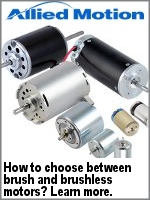 |
| December 27, 2022 | Volume 18 Issue 48 |
Motion Control News & Products
Designfax weekly eMagazine
Archives
Partners
Manufacturing Center
Product Spotlight
Modern Applications News
Metalworking Ideas For
Today's Job Shops
Tooling and Production
Strategies for large
metalworking plants
Choosing a stepper motor: PM or hybrid?
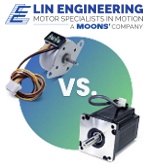 Lin Engineering stepper motors are widely used in various applications that require precise control of motion, such as in robotics, 3D printing, CNC machines, and medical equipment. There are two main types of stepper motors: permanent magnet (PM) and hybrid. Learn the differences, advantages, and when to use one type or the other.
Lin Engineering stepper motors are widely used in various applications that require precise control of motion, such as in robotics, 3D printing, CNC machines, and medical equipment. There are two main types of stepper motors: permanent magnet (PM) and hybrid. Learn the differences, advantages, and when to use one type or the other.
Read this informative Lin Engineering article.
Top Product: Integrated servo system is 20% smaller than standalone unit
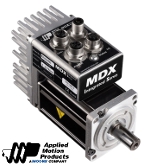 Applied Motion Products has introduced the MDX+ series, a family of low-voltage servo systems that integrate a servo drive, motor, and encoder into one package. This all-in-one drive unit is an ideal solution for manufacturers in logistics, AGV, medical, semiconductor, the solar industries, and many others.
Applied Motion Products has introduced the MDX+ series, a family of low-voltage servo systems that integrate a servo drive, motor, and encoder into one package. This all-in-one drive unit is an ideal solution for manufacturers in logistics, AGV, medical, semiconductor, the solar industries, and many others.
Read the full article.
Overhung load adaptors provide load support and contamination protection
 Overhung load adaptors (OHLA) provide both overhung radial and axial load support to protect electrified mobile equipment motors from heavy application loads, extending the lifetime of the motor and alleviating the cost of downtime both from maintenance costs and loss of production. They seal out dirt, grime, and other contaminants too. Zero-Max OHLAs are available in an extensive offering of standard models (including Extra-Duty options) for typical applications or customized designs.
Overhung load adaptors (OHLA) provide both overhung radial and axial load support to protect electrified mobile equipment motors from heavy application loads, extending the lifetime of the motor and alleviating the cost of downtime both from maintenance costs and loss of production. They seal out dirt, grime, and other contaminants too. Zero-Max OHLAs are available in an extensive offering of standard models (including Extra-Duty options) for typical applications or customized designs.
Learn more.
Why choose electric for linear actuators?
 Tolomatic has been delivering a new type of linear motion technology that is giving hydraulics a run for its money. Learn the benefits of electric linear motion systems, the iceberg principle showing total cost of ownership, critical parameters of sizing, and conversion tips.
Tolomatic has been delivering a new type of linear motion technology that is giving hydraulics a run for its money. Learn the benefits of electric linear motion systems, the iceberg principle showing total cost of ownership, critical parameters of sizing, and conversion tips.
Get this informative e-book. (No registration required)
New AC hypoid inverter-duty gearmotors
 Bodine Electric Company introduces 12 new AC inverter-duty hypoid hollow shaft gearmotors. These type 42R-25H2 and 42R-30H3 drives combine an all-new AC inverter-duty, 230/460-VAC motor with two hypoid gearheads. When used with an AC inverter (VFD) control, these units deliver maintenance-free and reliable high-torque output. They are ideal for conveyors, gates, packaging, and other industrial automation equipment that demands both high torque and low power consumption from the driving gearmotor.
Bodine Electric Company introduces 12 new AC inverter-duty hypoid hollow shaft gearmotors. These type 42R-25H2 and 42R-30H3 drives combine an all-new AC inverter-duty, 230/460-VAC motor with two hypoid gearheads. When used with an AC inverter (VFD) control, these units deliver maintenance-free and reliable high-torque output. They are ideal for conveyors, gates, packaging, and other industrial automation equipment that demands both high torque and low power consumption from the driving gearmotor.
Learn more.
Next-gen warehouse automation: Siemens, Universal Robots, and Zivid partner up
 Universal Robots, Siemens, and Zivid have created a new solution combining UR's cobot arms with Siemens' SIMATIC Robot Pick AI software and Zivid's 3D sensors to create a deep-learning picking solution for warehouse automation and intra-logistics fulfillment. It works regardless of object shape, size, opacity, or transparency and is a significant leap in solving the complex challenges faced by the logistics and e-commerce sectors.
Universal Robots, Siemens, and Zivid have created a new solution combining UR's cobot arms with Siemens' SIMATIC Robot Pick AI software and Zivid's 3D sensors to create a deep-learning picking solution for warehouse automation and intra-logistics fulfillment. It works regardless of object shape, size, opacity, or transparency and is a significant leap in solving the complex challenges faced by the logistics and e-commerce sectors.
Read the full article.
Innovative DuoDrive gear and motor unit is UL/CSA certified
 The DuoDrive integrated gear unit and motor from NORD DRIVE-SYSTEMS is a compact, high-efficiency
solution engineered for users in the fields of intralogistics, pharmaceutical, and the food and beverage industries. This drive combines a IE5+ synchronous motor and single-stage helical gear unit into one compact housing with a smooth, easy-to-clean surface. It has a system efficiency up to 92% and is available in two case sizes with a power range of 0.5 to 4.0 hp.
The DuoDrive integrated gear unit and motor from NORD DRIVE-SYSTEMS is a compact, high-efficiency
solution engineered for users in the fields of intralogistics, pharmaceutical, and the food and beverage industries. This drive combines a IE5+ synchronous motor and single-stage helical gear unit into one compact housing with a smooth, easy-to-clean surface. It has a system efficiency up to 92% and is available in two case sizes with a power range of 0.5 to 4.0 hp.
Learn more.
BLDC flat motor with high output torque and speed reduction
 Portescap's 60ECF brushless DC slotted flat motor is the newest frame size to join its flat motor portfolio. This 60-mm BLDC motor features a 38.2-mm body length and an outer-rotor slotted configuration with an open-body design, allowing it to deliver improved heat management in a compact package. Combined with Portescap gearheads, it delivers extremely high output torque and speed reduction. Available in both sensored and sensorless options. A great choice for applications such as electric grippers and exoskeletons, eVTOLs, and surgical robots.
Portescap's 60ECF brushless DC slotted flat motor is the newest frame size to join its flat motor portfolio. This 60-mm BLDC motor features a 38.2-mm body length and an outer-rotor slotted configuration with an open-body design, allowing it to deliver improved heat management in a compact package. Combined with Portescap gearheads, it delivers extremely high output torque and speed reduction. Available in both sensored and sensorless options. A great choice for applications such as electric grippers and exoskeletons, eVTOLs, and surgical robots.
Learn more and view all the specs.
Application story: Complete gearbox and coupling assembly for actuator system
 Learn how GAM engineers not only sized and selected the appropriate gear reducers and couplings required to drive two ball screws in unison using a single motor, but how they also designed the mounting adapters necessary to complete the system. One-stop shopping eliminated unnecessary components and resulted in a 15% reduction in system cost.
Learn how GAM engineers not only sized and selected the appropriate gear reducers and couplings required to drive two ball screws in unison using a single motor, but how they also designed the mounting adapters necessary to complete the system. One-stop shopping eliminated unnecessary components and resulted in a 15% reduction in system cost.
Read this informative GAM blog.
Next-gen motor for pump and fan applications
 The next evolution of the award-winning Aircore EC motor from Infinitum is a high-efficiency system designed to power commercial and industrial applications such as HVAC fans, pumps, and data centers with less energy consumption, reduced emissions, and reduced waste. It features an integrated variable frequency drive and delivers upward of 93% system efficiency, as well as class-leading power and torque density in a low-footprint package that is 20% lighter than the previous version. Four sizes available.
The next evolution of the award-winning Aircore EC motor from Infinitum is a high-efficiency system designed to power commercial and industrial applications such as HVAC fans, pumps, and data centers with less energy consumption, reduced emissions, and reduced waste. It features an integrated variable frequency drive and delivers upward of 93% system efficiency, as well as class-leading power and torque density in a low-footprint package that is 20% lighter than the previous version. Four sizes available.
Learn more.
Telescoping linear actuators for space-constrained applications
 Rollon's new TLS telescoping linear actuators enable long stroke lengths with minimal closed lengths, which is especially good for applications with minimal vertical clearance. These actuators integrate seamlessly into multi-axis systems and are available in two- or three-stage versions. Equipped with a built-in automated lubrication system, the TLS Series features a synchronized drive system, requiring only a single motor to achieve motion. Four sizes (100, 230, 280, and 360) with up to 3,000-mm stroke length.
Rollon's new TLS telescoping linear actuators enable long stroke lengths with minimal closed lengths, which is especially good for applications with minimal vertical clearance. These actuators integrate seamlessly into multi-axis systems and are available in two- or three-stage versions. Equipped with a built-in automated lubrication system, the TLS Series features a synchronized drive system, requiring only a single motor to achieve motion. Four sizes (100, 230, 280, and 360) with up to 3,000-mm stroke length.
Learn more.
Competitively priced long-stroke parallel gripper
 The DHPL from Festo is a new generation of pneumatic long-stroke grippers that offers a host of advantages for high-load and high-torque applications. It is interchangeable with competitive long-stroke grippers and provides the added benefits of lighter weight, higher precision, and no maintenance. It is ideal for gripping larger items, including stacking boxes, gripping shaped parts, and keeping bags open. It has high repetition accuracy due to three rugged guide rods and a rack-and-pinion design.
The DHPL from Festo is a new generation of pneumatic long-stroke grippers that offers a host of advantages for high-load and high-torque applications. It is interchangeable with competitive long-stroke grippers and provides the added benefits of lighter weight, higher precision, and no maintenance. It is ideal for gripping larger items, including stacking boxes, gripping shaped parts, and keeping bags open. It has high repetition accuracy due to three rugged guide rods and a rack-and-pinion design.
Learn more.
Extend your range of motion: Controllers for mini motors
 FAULHABER has added another extremely compact Motion Controller without housing to its product range. The new MC3603 controller is ideal for integration in equipment manufacturing and medical tech applications. With 36 V and 3 A (peak current 9 A), it covers the power range up to 100 W and is suitable for DC motors with encoder, brushless drives, or linear motors.
FAULHABER has added another extremely compact Motion Controller without housing to its product range. The new MC3603 controller is ideal for integration in equipment manufacturing and medical tech applications. With 36 V and 3 A (peak current 9 A), it covers the power range up to 100 W and is suitable for DC motors with encoder, brushless drives, or linear motors.
Learn more.
When is a frameless brushless DC motor the right choice?
 Frameless BLDC motors fit easily into small, compact machines that require high precision, high torque, and high efficiency, such as robotic applications where a mix of low weight and inertia is critical. Learn from the experts at SDP/SI how these motors can replace heavier, less efficient hydraulic components by decreasing operating and maintenance costs. These motors are also more environmentally friendly than others.
Frameless BLDC motors fit easily into small, compact machines that require high precision, high torque, and high efficiency, such as robotic applications where a mix of low weight and inertia is critical. Learn from the experts at SDP/SI how these motors can replace heavier, less efficient hydraulic components by decreasing operating and maintenance costs. These motors are also more environmentally friendly than others.
View the video.
Tiny and smart: Step motor with closed-loop control
 Nanotec's new PD1-C step motor features an integrated controller and absolute encoder with closed-loop control. With a flange size of merely 28 mm (NEMA 11), this compact motor reaches a max holding torque of 18 Ncm and a peak current of 3 A. Three motor versions are available: IP20 protection, IP65 protection, and a motor with open housing that can be modified with custom connectors. Ideal for applications with space constraints, effectively reducing both wiring complexity and installation costs.
Nanotec's new PD1-C step motor features an integrated controller and absolute encoder with closed-loop control. With a flange size of merely 28 mm (NEMA 11), this compact motor reaches a max holding torque of 18 Ncm and a peak current of 3 A. Three motor versions are available: IP20 protection, IP65 protection, and a motor with open housing that can be modified with custom connectors. Ideal for applications with space constraints, effectively reducing both wiring complexity and installation costs.
Learn more.
NASA says its all-electric airplane rides on the wings of U.S. small businesses
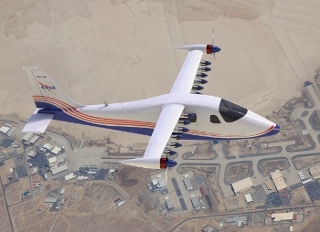
This artist's concept shows NASA's first all-electric X-plane, the X-57 Maxwell, in its final configuration. In Mod IV test flights, X-57's high-lift motors will deactivate during cruise mode, and the propeller blades will fold into the nacelles to reduce drag. The motors will reactivate and use centrifugal force to spin the blades back out to provide necessary lift for landing. [Credits: NASA Langley/Advanced Concepts Lab, AMA, Inc.]
About the X-57 "Maxwell" program: X-57 is a highly modified Tecnam P2006T aircraft that features the replacement of traditional combustion engines and wing with an experimental distributed electric propulsion system.
NASA will install 12 electric high-lift motors and propellers into the final configuration of X-57, called Modification IV, or Mod IV.
Positioned along the leading edge of X-57's cruise-efficient wing, these motors and propellers will be utilized first during takeoff, providing lift augmentation to the X-Plane at low aircraft speeds. Once X-57 goes into cruise mode, the motors will deactivate, and the propeller blades will fold inward to prevent creating additional drag while two larger electric cruise motors remain active on the wing tips. Then, when it's time to land, the smaller high-lift motors will reactivate, unfolding the propeller blades to create the appropriate lift for landing at approach speed.
---------------
By Bailey Light, Outreach & Engagement Specialist, NASA SBIR/STTR Program
NASA's X-57 "Maxwell," the agency's experimental all-electric aircraft, is working to provide industry and regulators with knowledge that will revolutionize sustainable aviation. Developing that knowledge involved more than a decade of close alignment between NASA and its private sector partners -- and that started with support for a small business.
Creating this novel aircraft required intense research and development, and to produce that, NASA has worked with Empirical Systems Aerospace (ESAero), a small business based in San Luis Obispo, CA. ESAero, the prime contractor for the X-57 project, provided support for air vehicle and all-electric propulsion design, analysis, manufacturing, integration, ground testing, diagnostic tools, and software modeling for the aircraft.
ESAero's early efforts in electric aircraft research were supported by NASA through its Small Business Innovation Research and Small Business Technology Transfer (SBIR/STTR) program. In 2009, the company received its first NASA SBIR award to design and analyze the efficiency of novel all- and hybrid-electric aircraft concepts. Stemming from this and later SBIR awards came the experimental Scalable Convergent Electric Propulsion Technology Operations Research (SCEPTOR) aircraft, later designated as the X-57 Maxwell.
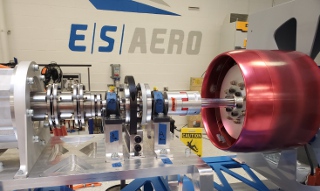
As part of the verification and validation process, the all-electric cruise motors to be used on NASA's X-57 Maxwell have begun several rounds of high-power and endurance tests at ESAero. The lessons learned from the cruise motor tests will help in the effort to set airworthiness standards for electric aircraft. [Credits: Empirical Systems Aerospace]
Starr Ginn was an early supporter of NASA's electric aircraft research. During ESAero's early days developing SCEPTOR, Ginn served as deputy aeronautics research director at Armstrong Flight Research Center in Edwards, CA. In this role, she issued the NASA SBIR/STTR program's call for proposals related to flight testing, including hybrid electric aircraft. She also assisted ESAero as the company's SBIR work evolved to larger scales. A Phase III NASA SBIR award allowed ESAero to transition into the X-57 project's prime contractor.
During her time on the project, Ginn said she saw the X-57 aircraft serve as an important partnership between the private and public sectors.
"This industry of building electric airplanes is very competitive," said Ginn, who now serves as NASA's Advanced Air Mobility lead strategist. "Having a NASA-sponsored project, where we get to share all our lessons learned with the public, allows the industry to grow. The X-57 project has been a wealth of knowledge so people don't have to reinvent the wheel."
The X-57 project is a team effort. It has involved collaboration among NASA's Armstrong Flight Research Center, its Langley Research Center in Hampton, VA, and its Glenn Research Center in Cleveland. ESAero has also added multiple small business subcontractors to the team of industry innovators supporting research and development of the electric aircraft:
- Urban Air Mobility industry innovator Joby Aviation of Santa Cruz, CA, supplied the JMX57 air-cooled electric cruise motors and controllers
- Battery innovator Electric Power Systems EPS of Logan, UT, is responsible for development of the aircraft's battery system
- Sierra Technical Services of Tehachapi, CA, supported design, packaging, and cooling improvements on the cruise nacelle and the manufacturing of composite parts
- TMC Technologies of Fairmont, WV, supported the validation and verification of all the software systems
The X-57 aircraft plans to make its inaugural test flight in 2023 and continues to be a pathfinder for a new generation of electric aircraft. Its success thus far serves as a testament to the importance of NASA's investments in American small businesses and the sharing of knowledge.
"NASA's work with the private sector on this project has brought a lot of transparency to the industry, and the companies have been able to grow themselves," said Ginn. "That's a big part of SBIRs. The government takes on the high-risk ideas and helps mature them to where they become a viable product for industry."
The NASA SBIR/STTR program is part of NASA's Space Technology Mission Directorate (STMD) and is managed by NASA's Ames Research Center in Silicon Valley. The X-57 project was also bolstered by STMD's Center Innovation Fund, which supported research into electric systems that was used to develop technology for the advanced aircraft.
To learn more about NASA's SBIR/STTR program and apply to future opportunities, go to https://sbir.nasa.gov/.
Published December 2022
Rate this article
View our terms of use and privacy policy
